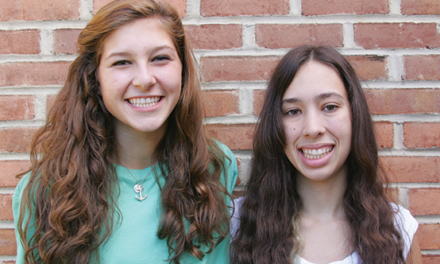 An Arizona program seeking to help students become more career-ready and aware helps teachers learn what the workforce of the future will need.
An Arizona program seeking to help students become more career-ready and aware helps teachers learn what the workforce of the future will need.
In the preface to What the Dog Saw, Malcolm Gladwell describes the curiosity people have about what others do for work. This interest goes deeper still: We also want to know what it feels like and what it means to be a doctor, a teacher, or to sell cars.
“Curiosity about the interior life of other people’s day-to-day work is one of the most fundamental human impulses,” Gladwell writes (2009, p. x).
That’s the curiosity behind the frequent student question: “When will I ever use this?” As much as teachers try to relate learning to the world of work and make clear what will be expected of students when they choose certain career paths, that question doesn’t always have an easy answer. Teachers who enter the classroom from other professions can speak to their previous fields, but most teachers’ knowledge of the everyday requirements of other professions is understandably limited.
Today’s classrooms place significant emphasis on helping students learn not just for the sake of learning but to become prepared to take their place in the workforce. Teachers across the U.S. know students must be ready for college and career, but many may not be able to translate that into the skills, competencies, and lessons they need to teach to prepare and animate students for the world of work.
Meanwhile, employers look to schools to nurture and empower savvy job candidates of the future — young adults prepared with the skills and critical dispositions necessary for the jobs they have to offer. So what can teachers do to learn more about the demands and life of different careers? And what can employers do to keep teachers up to date with current workforce demands?
They can participate in Lesson2Life.
An exemplar program
Lesson2Life is a professional development partnership between the Arizona K12 Center at Northern Arizona University, Arizona Public Service (APS), and local businesses and chambers of commerce throughout the state. Participating teachers gain insight into today’s workforce so they can then teach students the skills and information necessary to be successful when they seek careers of their own.
Lesson2Life is designed to give teachers real-world insights into today’s workforce with the hope that they will be more prepared to help students gain the skills and information they need when they seek careers of their own.
The skills and information that teachers say they’re now teaching, such as the need to work on more than one problem at a time, are not local. So while this program is currently based in Arizona, it has huge potential to spread to other states.
Taking place over three days, Lesson2Life consists mostly of site visits or “learning exchanges” to local businesses. Teachers tour facilities, participate in group activities, hear talks by business leaders, and engage in open-ended discussions about education and careers. At the end of the program, participants meet for a celebratory luncheon to discuss what they learned and how they plan to implement what they learned in their classrooms.
Lesson2Life spans a broad swath of Arizona geography and businesses. There are programs in Phoenix, Tucson, Yuma, and Flagstaff, with a wide range of companies taking part in other communities. During a typical summer, 100 teachers from about 18 different school districts throughout Arizona participate in Lesson2Life. They do this voluntarily, wanting to engage with other educators and businesses to learn more about workplace skills and how to embed them in their curriculum. Participants have access to an impressive variety of sectors: science, technology, hospitality, arts, nonprofits, large businesses, start-ups, and more. Teachers may visit a call center whose employees are just out of high school on one day; the next day, they might visit a nonprofit where everyone has a master’s or Ph.D. in a STEM field.
Sans pedagogy
In contrast to nearly all professional development, Lesson2Life doesn’t promote a specific teaching style or pedagogy. It’s not about methods or how students learn. It definitely isn’t about test preparation.
Leah Varney, a middle school computer teacher who participated for the first time last summer, said Lesson2Life bridges the gap between teaching and nonteaching professions. “Lesson2Life is different because teachers are working directly with companies,” she said. During site visits, Varney asks specific questions to make sure she has the most up-to-date knowledge about skills and characteristics that employers are seeking. “Now I have a firsthand account to share with my students when describing possible workplaces they could apply to in the future,” she said. She’s already marked her calendar to participate next year.
Varney also found it refreshing to make her own connections from what she learned in Lesson2Life to her content area — instead of being force-fed what a presenter wants her to think. Instead of prewritten lesson plans, Varney comes away from each learning exchange with new challenging ideas and concepts to work into her existing curriculum.
Special education teacher Gerald Neal said Lesson2Life was his first professional development experience that didn’t involve sitting in a classroom or at a computer. “It was much more engaging and fun, so it made learning easier,” he said.
Business partners point out the mutual benefits for educators and business employees. David Hinderliter, an engineer at Intel, appreciates the opportunity to interact directly with teachers. “It is truly unique in the sense that the teachers can discuss issues and challenges in the education field in a risk-free environment,” he said. When he works with educators or universities, it’s usually part of a Ph.D. or university program. “That can become quite tedious or boring and generally create little immediate value to society,” Hinderliter said.
Learning from each other
Lesson2Life learning exchanges offer valuable opportunities for teachers to learn about other careers. But they can also challenge or confirm preconceptions that teachers may have about different professions.
Sandy Merz, coauthor and a middle school engineering and algebra teacher, appreciates learning about different business cultures and communication styles that emerge from different missions. For example, the flashy culture of the promotions department at a local mall reflected popular trends, and employees at that company tended to be informal in their communication with one another. In comparison, the no-nonsense culture of an electric company reflected the utilitarian demands of getting needed power to customers, and their internal communication appeared more methodical and focused. However, Merz observed that both companies had cultures that were comfortable with humor and could function under great stress.
Then there’s teamwork. Whether promoting a charity event or delivering electricity during summer heat waves, all businesses must fill a similar range of jobs. Teachers who participate in Lesson2Life get to observe similarities in organizational structures and watch teamwork in action. From accounting to marketing to technical staff, teachers witness the importance of collaboration.
Middle school teacher Varney describes another insight she gained about the efforts that make creating and delivering different products possible. “I realized my students needed to be exposed to working on multiple requirements at once,” she said. “In the past, I’ve focused students’ attention on one large requirement at a time. This is not standard practice. Employees must juggle multiple responsibilities. If I don’t expose my students to this environment, they will not have the background to succeed once leaving school.”
Business leaders’ views
Teachers recently toured Flagstaff’s Nestle Purina manufacturing facility with human resources manager Jeff Gamet. He helped them understand from an educational standpoint what it takes to work in manufacturing. Gamet said teachers did not know that pet food is as highly regulated as human food or that manufacturing is mostly automated and requires very little manual labor. The high wages and benefits offered at the company impressed teachers, too. Teachers also learned that apart from basic technical skills most of the requirements of modern factory work are nearly universal: problem solving, leadership, willingness to work in a team environment, and a readiness to learn.
Business leaders see Lesson2Life as a way to ensure they will find the right people to fill jobs in the future.
In a similar vein, Randy Clawson, APS’s technical account representative, said communication is a vital skill in new hires. He pointed out that many kids tend to write things in abbreviated styles (like text messages), which doesn’t develop the kind of communication skills his company needs. “We try to stress that written and verbal communications are very important,” Clawson said.
Anika Bausom, senior designer at Rain Visual Strategy + Design, a graphic design business, also emphasized the need for communication and problem-solving skills. “It’s about the ability to ask intelligent questions,” she said, “where to look for answers, how to work in a team, and communicate with other people.”
She said students and teachers might be surprised at how many basic disciplines (besides graphic design itself) are incorporated in the work at her company. “In graphic design, you need to be able to function on a computer as well as have math, reading, and writing skills. We need to be able to read and write and go over the copy we’re using. It’s important to have a well-rounded education,” she said.
A recruiting tool
Business leaders see Lesson2Life as a way to ensure they will find the right people to fill jobs in the future. As Bausom said, “In the long run, we’re providing information about the types of skills we want future workers to have.” Teachers can then translate those skills and knowledge to students.
Clawson noted that APS has an aging employee base and that it will need to replace those workers with similarly skilled people in the future. “Lesson2Life is almost a mini-recruitment tool,” Clawson said. “We’re exposing students to opportunities to join an electric utility, and, kind of selfishly, we’re looking for future employees.”
In short, both companies and students must adapt for the future. Intel engineer Hinderliter observes that teachers are experts at detecting and understanding human issues. He finds it illuminating to engage with teachers because “they provide advance notice of societal issues long before society and even parents become aware of problems,” he said. And when he talks with teachers about insufficient budgets, support problems, and disconnects between teachers and administrators, Hinderliter said, he gains insights into how his company’s human resources and public relations departments also need to adjust.
Building community ties
Another mutual benefit is that Lesson2Life enables two-way community building. Special education teacher Neal and middle school teacher Varney both pointed out the probability of future collaboration with business professionals they had met. “Lesson2Life provides the missing link between teachers who desire to work with community members and business who seek to reach out to schools,” Varney said.
Hinderliter said he’s been able to directly inform teachers about many resources that Intel provides to teachers worldwide — such as technology teaching curricula, guest speakers, in-class experiments, and lessons on how to use technology in the classroom.
Lesson2Life connects teachers and the business community in order to develop innovative classrooms and to build long-standing ties between teachers and businesses, who have much to learn from each other.
From accounting to marketing to technical staff, teachers witness the importance of collaboration.
Across the curriculum
For students to become career-ready, all teachers must give students abundant opportunities to practice the skills mentioned above. Additionally, teachers should work to satisfy the natural curiosity that kids have about the outer and inner worlds of work.
Lesson2Life really does help teachers answer the dreaded “When will I use this in the real world?” question. Varney offers a powerful example. When kids ask about the value of communication skills she teaches, she responds: “In the real world, employers need workers with the confidence to express opinions while contributing to their team.”
Teachers are adapting their teaching in a variety of ways to prepare students for the current and future business climate. Even early childhood teachers are finding creative ways to help small children learn about job and life skills. For example, one kindergarten teacher devised an innovative system to give students access to different learning centers throughout the classroom. Each time they move from one center to the next, students log their time by “clocking in” and “clocking out.”
Similarly, a physical education teacher altered his grading system to reflect whether students showed up on time, participated, came in uniform, and were prepared and engaged in class — rather than whether they were skilled at a particular game or sport.
Business partners understand the need to develop these skills across a wide variety of classrooms and content areas. “I believe the direct communication between Lesson2Life speakers and teachers is the most effective way to emphasize the importance of creativity, teamwork, cross-cultural communication skills, resilience, motivation, and positive attitude,” Hinderliter said.
Conclusion
In the four years I’ve attended the program, Lesson2Life has added lots of tools to my teaching. I’ve tweaked my engineering simulations for model workplaces. Most of the problems I challenge my engineering students with are far more open-ended and systems oriented than they used to be. Beyond seeing how a self-contained system works, I want students to learn how multiple systems connect. So I create projects that show how a change in one system affects others that aren’t obviously connected.
In my algebra class, I used to show students a formula and then give them some canned word problems to practice applying it. Now, I’m willing to take a whole class period to discuss what would be involved in trying to mathematically prove or disprove the claim that carpool lanes on freeways reduce emissions.
When students complain that I need to give them formulas, I hit them with the story of an actuary at Scottsdale Insurance. She was tasked to figure out how to insure an extremely unusual situation — like someone winning a million dollars for a hole-in-one at a golf tournament. She asked her supervisor how to go about it, and the supervisor replied, “That’s what I hired you to figure out.”
Furthermore, I frame all my classroom management in terms of workplace preparation. Instead of talking about complying with rules, I tell them that Intel actually evaluates candidates on their communication and teamwork skills before even looking at their technical qualifications.
Being equipped with authentic answers to the “When am I ever. . . ” question has paid a surprising dividend compared to canned answers. A real answer about real work addresses the natural curiosity of students, and they pay much closer attention. I’ve discovered that they’re satisfied to know not just when they might use the content but that it really does matter to someone somewhere.
Here’s a true story: I was with a group of teachers visiting Critical Path, a nonprofit working to get new medicines to market in less than 10 years and for less than a billion dollars. We completed a role-playing activity that simulated the task of getting a new drug approved by the FDA. After the simulation, we debriefed our performance with Critical Path professionals that included an epidemiologist, a neuroscientist, and an engineer. A teacher asked, “Does anyone ever really use box and whisker diagrams?” The epidemiologist said, “Oh, yeah, I use them all the time!” The engineer and neuroscientist enthusiastically agreed.
Bingo! I now have a real, compelling answer the next time a student asks me that question.
Reference
Gladwell, M. (2009). What the dog saw. New York, NY: Little Brown & Co.
CITATION: Merz, S. & Wiebke, K. (2015). Business fills a gap between teacher and student. Phi Delta Kappan, 96 (6), 33-37.
ABOUT THE AUTHORS

Kathy Wiebke
KATHY WIEBKE is a National Board Certified Teacher and executive director of the Arizona K12 Center at Northern Arizona University, Flagstaff, Ariz.

Sandy Merz
SANDY MERZ is an engineering and algebra teacher at Safford K-8 Magnet School, Tucson, Ariz., and a member of the Collaboratory at teachingquality.org.










